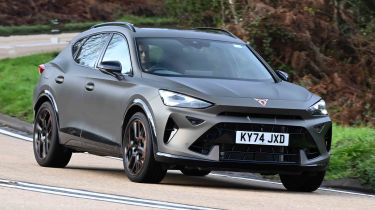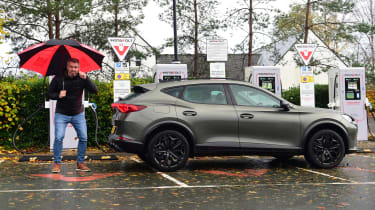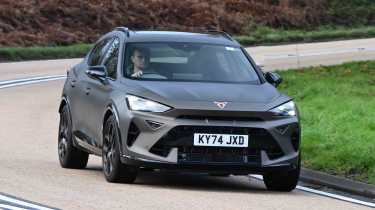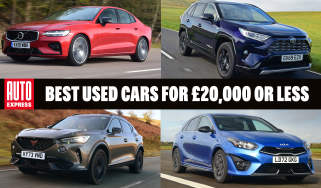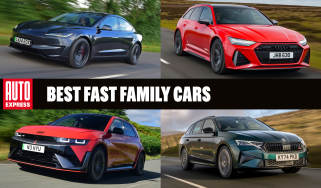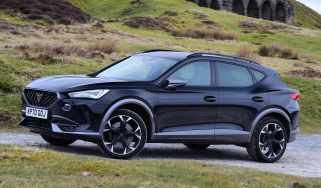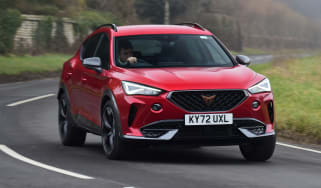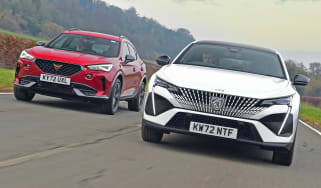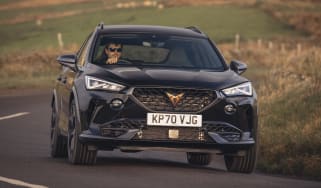Cupra Formentor review
The Cupra Formentor is a sporty, coupe-SUV that’s talented enough to mix it with more established, premium rivals
Our opinion on the Cupra Formentor
The Cupra Formentor has been a real success for the sporty Spanish brand since its launch back in 2020. Its athletic styling and unique copper detailing help it stand out in a crowded small SUV marketplace that includes mainstream and more premium rivals.
The Formentor has always been good to drive, and there’s a good choice of petrol engines to consider, although the entry 148bhp models feel a little out of kilter with the overall sporty brand ethos. A recent facelift means that the plug-in hybrid models offer greater efficiency than ever before, while the top-of-the-range, all-wheel-drive versions continue to provide plenty of performance. Refinements to the infotainment system are welcome, although one downside is that some cabin materials aren’t quite at the level you might expect. But if you’re after a practical family car that prioritises the overall driving experience, and offers something a bit different to the SUV norm, then the Formenter is a solid choice.
| Key specs | |
| Fuel type | Petrol, plug-in hybrid |
| Body style | Coupe-SUV |
| Powertrain |
1.5-litre 4-cyl, petrol 1.5-litre 4-cyl, petrol PHEV 2.0-litre 4-cyl, petrol (front or all-wheel drive) |
| Safety | Five stars (Euro NCAP, 2021) |
| Warranty | Five years/90,000 miles |
About the Cupra Formentor
The Formentor slots between the Cupra Leon hatchback and the Cupra Ateca mid-size SUV in the Cupra model lineup, and we’d argue its sleek looks suit the more athletic image of the brand better than the boxlike Ateca. With its lower roofline, the Formentor can’t match the Ateca for headroom or boot space. But the Formentor is still quite long, so it’s a practical car with a decent amount of space in the back, and up to 450 litres of cargo space – provided you pick the correct version.
Used - available now

2024 Cupra
Formentor
40,012 milesAutomaticPetrol1.4L
Cash £18,800
2024 Cupra
Formentor
8,991 milesAutomaticPetrol2.0L
Cash £25,340
2024 Cupra
Formentor
59,637 milesAutomaticPetrol1.4L
Cash £18,197
2024 Cupra
Formentor
37,296 milesAutomaticPetrol1.4L
Cash £20,012The range, facelifted in late 2024, starts at around £34,500 for the entry 148bhp 1.5-litre petrol car with a six-speed manual gearbox, while opting for the seven-speed automatic version costs a £2,000 premium. You’ll need an extra £7,000 on top of that if you’d rather have a plug-in hybrid model, with all these prices applying to V1 specification cars. Moving up the range to the V2 and V3 trim levels means you’ll pay around £2,000 and £4,500 extra, respectively, with the 201bhp V3 e-Hybrid available for a touch over £46,000.
If you’re after more performance, then the VZ-badged side of the Formentor range opens things up further. The 262bhp 2.0-litre model in VZ1 trim kicks things off at around £43,000, while the 328bhp 2.0-litre all-wheel drive VZ3 model surpasses the £54,000 mark.
If the Cupra's curvaceous SUV has caught your eye, you can configure your ideal Cupra Formentor right now and get the best offers from dealers near you. You can also findt the latest Formentor leasing deals or look for used Formentors via our Find A Car service. If you need to sell your existing car, be sure to take a look at Auto Express Sell My Car.
Performance & driving experience
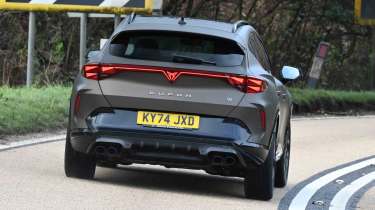
| Pros |
|
| Cons |
|
The Formentor engine range offers a decent array of options: the 148bhp 1.5-litre petrol (with either a six-speed manual or a seven-speed automatic transmission), and the 201bhp 1.5-litre plug-in hybrid are offered in combination with either the V1, V2, or V3 specifications, while you can have a 262bhp 2.0-litre petrol, a 268bhp 1.5-litre plug-in hybrid or a 328bhp 2.0-litre all-wheel-drive petrol model with any of the VZ1, VZ2 or VZ3 trim levels. All Formentors are front-wheel drive with the exception of the top-of-the-range 2.0-litre model.
Company car drivers may be interested in the 201bhp or 268bhp e-Hybrid versions, both of which use a six-speed automatic and an electric motor. Whereas the pre-facelifted PHEV models provided around 34 to 37 miles of all-electric range, the latest plug-in hybrids feature a larger 25.8kWh battery and more than 70 miles of emissions-free motoring.
Performance, 0-60mph acceleration and top speed
The Formentor has some of the more powerful engines from the SEAT line-up, so there’s not a particularly slow version in the range. A 1.5-litre petrol with 148bhp kicks off proceedings, and it should have plenty of performance for most buyers. However, we think its 0-62mph time of 9.0 seconds doesn’t sit quite right with the Cupra brand’s athletic ethos. Luckily, there are punchier options – if you can afford them.
Performance fans will be pleased to find that the facelifted Formentor range now includes a 328bhp 2.0-litre petrol model. Thanks to standard-fit four-wheel drive and 420Nm of torque, the 0-62mph dash is dispatched in just 4.8 seconds, with a top speed of 155mph. Cupra has also introduced (as of November 2024) a 261bhp 2.0-litre petrol version.
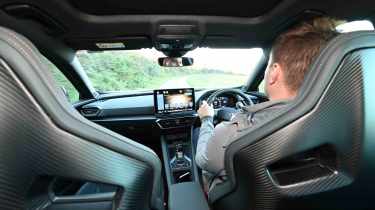
Town driving, visibility and parking
Whichever Cupra Formentor model you choose, you’ll find it pretty straightforward to drive in and around town. If urban routes are where most of your driving takes place, then it’d probably make most sense to opt for the 148bhp petrol, or the lower-powered E-Hybrid - simply based on cost and overall efficiency.
The e-Hybrid models are a bit underwhelming when driven with any vigour; neither can shrug off the weight penalty of a heavy battery pack, making these versions feel slightly less agile in the corners, plus the suspension has had to be stiffened to compensate for the extra weight, so these versions don’t ride as well. Nor do they sound particularly inspiring when pushed, so a more sedate driving style in town making the most of its all-electric range suits this version best.
B-road driving and handling
Fortunately, the 328bhp 2.0-litre TSI petrol version helps to redeem the Formentor range. The Comfort, Performance, Cupra and Individual driving modes all provide a genuinely different experience through the chassis, steering wheel weight and drivetrain response. We tested the previous 306bhp version to its firmest and fastest settings, but we soon found that the Cupra mode is best left at the track, because it’s far too firm for British roads. The steering also gets heavier but doesn’t have any more feel, so it actually becomes slightly less enjoyable to drive.
It’s best to keep it in the less hardcore driving modes, where the more comfort-oriented settings of the adaptive suspension fitted to VZ1 trims and above allow the Formentor to ride very well on the road. The Cupra mode feels like it’s trying a little too hard, but the Normal mode is just right. There’s very little body roll and lots of grip, so you’ll feel confident in carrying some speed down a twisty country road. The quickest Formentor gets all-wheel drive as standard, which doesn’t turn it into an off-road champion, but does add a feeling of security with its additional traction in wintry driving conditions.
Motorway driving and long-distance comfort
In Comfort mode, you’ll find the Formentor is a perfectly pleasant car to rack up motorway miles. Road noise and wind noise are audible, although the SUV's naturally longer suspension travel (compared with a Leon) is happy to absorb bumps and ruts in the road – even on the larger 19-inch wheels the V2 and V3 models come with. (The basic V1 sits on 18-inch wheels).
“The Formentor is essentially a Volkswagen Golf R in a fancy frock, and it’s razor sharp to drive, with a suitably sporty soundtrack and limpet-like grip.” - Richard Ingram, deputy editor, who lived with a Cupra Formentor for six months as part of our long-term test fleet.
| Model | Power | 0-60mph | Top speed |
| TSI 150 | 148bhp | 9.0s | 127mph |
| e-Hybrid DSG-auto 204 | 201bhp | 7.9s | 130mph |
| e-HYBRID DSG-auto 272 | 268bhp | 7.2s | 137mph |
| Formentor TSI DSG-auto 4Drive 333 | 328bhp | 4.8s | 155mph |
MPG & running costs
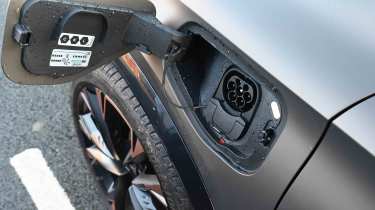
|
Pros |
|
| Cons |
|
Picking the 306bhp petrol engine will bring fairly chunky running costs; it’s a classic high-performance petrol, with four-wheel drive and an automatic gearbox, and up to 32.5mpg is the predictable outcome – although be prepared for your consumption readout to drop into the teens with fast driving. It occupies the highest 37 per cent Benefit-in-Kind (BiK) bracket because it puts out at least 192g/km of CO2, although that’s pretty similar to its main rivals, so par for the course if you’re looking at a petrol SUV with this much power.
The entry-level TSI 150 engine offers very acceptable efficiency. It returns 44.8mpg and 143g/km of CO2, which means it’ll be affordable to run for private buyers and avoids the top Benefit-in-Kind (BiK) tax band for company car drivers.
Business users will be far better off with either of the plug-in hybrids. CO2 emissions of 27-33g/km mean that BiK liability will be around a third as much as the petrol versions.
| Model | MPG | CO2 | Insurance group |
| TSI 150 | 43.5-44.8mpg | 138-142g/km | 19 |
| e-Hybrid DSG-auto 204 | 565-706.2mpg | 9-10g/km | 24 |
| e-HYBRID DSG-auto 272 | 470.8-706.2mpg | 10g/km | 26 |
Electric range, battery life and charge time
Both the 201bhp and 268bhp plug-in hybrid Formentors use a 25.8kWh battery that’s a similar size to other plug-in hybrid cars from the VW group, such as the Volkswagen Passat. This gives the Cupra Formentor in e-Hybrid a range of up to 77 miles in 201bhp form or 73 miles in 286bhp guise. As a result, the Cupra Formentor e-Hybrid sits in the five per cent BiK bracket (six per cent for the 2025/2026 tax year).
The maximum charging speed has increased dramatically compared with its previous iteration, from a relatively slow 3.6kW AC charging speed up to a maximum of 50kW using DC charging, enabling a 10-80 per cent top-up charge of just 26 minutes from a rapid charger. The latter is an expensive way of recharging the Formentor, so we expect most owners will utilise a typical 7.4kW home wallbox charger, which will take around four hours to fully recharge a Formentor plug-in hybrid from empty.
Insurance groups
Insurance premiums hopefully shouldn’t be too expensive if you’re driving a Formentor - unless of course, you opt for the top-of-the-range 328bhp all-wheel-drive model, which sits in group 35. The rest of the lineup occupies groups 21 to 35.
Tax
Every Formentor VZ model is subject to the luxury car tax (this applies to vehicles costing over £40,000), so this adds to an already expensive package. For business users, there are the choice of two e-Hybrid versions, although these can’t match fully-electric cars when it comes to Benefit-in-Kind tax savings.
In order to avoid paying a premium rate of road tax, you’ll need to stick with more affordable versions using the 1.5 TSI or 1.5 eTSI engines.
Depreciation
Choose an entry 148bhp Formentor, and you’ll benefit from the strongest residual values across the range: 47-48 per cent retained after three years and 36,000 miles. The e-Hybrid versions are a few points back on 43-45 per cent over the same period, while depreciation hits the 328bhp model hardest in VZ2 and VZ3 specifications (40-41 per cent). Go for the racy Formentor in VZ1 trim and you’ll keep around 47-48 per cent of its value.
To get an accurate valuation for a specific model, check out our free car valuation tool...
Interior, design & technology
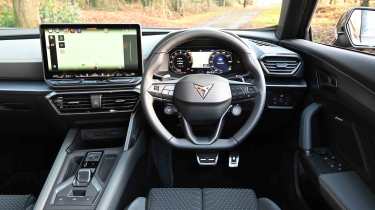
| Pros |
|
| Cons |
|
The updated Formentor features the ‘shark nose’ front end of Cupra’s all-electric line-up, along with triangular headlights, a neater grille and a completely revised bumper. A full-width light bar brightens up the rear of the car, showing off an illuminated central Cupra badge.
No matter which model you opt for, the Formentor delivers an impactful look, and the sporty flavour is complemented by the driver being able to find a suitably low driving position. The top-spec VZ3 includes impressive carbon-backed bucket seats that offer good support and plenty of comfort.
Interior and dashboard design
The Formentor has a much more modern and stylish interior than its Ateca sibling. A huge 12.9-inch central touchscreen is perched on top of the dashboard, and most of the climate controls have been migrated onto the screen to give a cleaner look, much to the detriment of usability on the move.
There’s also a digital instrument cluster that comes as standard, plus a steering wheel with copper detailing and a carbon fibre-effect centre.
Materials and build quality
The interior has enough classy touches to lift it above a standard SEAT – especially in either V2, V3, or VZ specification, which get a leather-covered dashboard. Look down, and you’ll see a lot of familiar switchgear and the stubby gearlever out of the latest Volkswagen Golf, but overall, the interior still feels quite special. You’ll still find some cheaper plastics lower down that don’t quite cut the mustard in a £40,000 car, and we also think that the flappy paddles behind the steering wheel don’t feel premium enough.
Infotainment, sat-nav and stereo
Every Formentor version now features a new 12.9-inch touchscreen. In terms of functionality, it’s not a massive step forward, but it’s more intuitive than before, while some bespoke graphics make it feel distinct from other VW Group models. The divisive climate control touch sliders are thankfully now illuminated too.
There are some useful shortcuts on the climate control page, such as a setting to warm your feet, and another to cool the cabin, but we still prefer physical buttons to make things easier to find while you’re driving.
Wireless Apple CarPlay and wired Android Auto smartphone connectivity are both standard, so you can bypass Cupra’s software for the most part. You get four USB-C ports (two for the front seat occupants and two for those in the rear) to keep your devices topped up, plus standard wireless phone charging.
A seven-speaker audio system with Bluetooth and DAB radio is standard across the range, while the VZ3 model upgrades to a ten-speaker arrangement courtesy of Sennheiser.
If you’re prioritising overall practicality, then you might find that the Formentor is a little compromised – particularly in terms of boot space. But, Cupra has ensured its sporty SUV comes laden with useful touches to make life on the road just a bit easier to manage.
Standard kit includes electrically adjustable, folding and heated door mirrors, wireless smartphone charging, three-zone climate control and integrated navigation with a three-year subscription to features such as online traffic information and map updates. Take a step up from the entry V1 specification and you’ll benefit from heated front seats, a power tailgate and a rear view camera.
“The Formentor feels much nicer than a VW Golf inside, but it still can’t quite match up to Audi’s standard when it comes to material quality in the cabin. Most of the plastics are soft, and the seats are great, but there are a few areas where it feels like there’s been some money saved in the Formentor.” - Sean Carson, Auto Express contributor, who drove the Cupra Formentor on a long-term test.
Boot space & practicality
| Pros |
|
| Cons |
|
If you’re prioritising overall practicality then you might find that the Formentor is a little compromised - particularly in terms of boot space. But, Cupra has ensured its sporty SUV comes laden with useful touches to make life on the road just a bit easier to manage.
Standard kit includes electrically adjustable, folding and heated door mirrors, wireless smartphone charging, three-zone climate control and integrated navigation with a three-year subscription to features such as online traffic information and map updates. Take a step up from the entry V1 specification and you’ll benefit from heated front seats, a power tailgate and a rear view camera.
Dimensions and size
The Formentor is 4,451mm long, 1,839mm wide (excluding mirrors) and 1,511mm tall, which means it’s not as long or as wide as a Peugeot 408, but it is slightly taller. The Formentor is a tad longer than the Cupra Ateca, though.
| Dimensions | |
| Length | 4,451mm |
| Width | 1,839mm |
| Height | 1,511mm |
| Number of seats | Five |
| Boot space | 450 litres (1.5 TSI & 1.5 eTSI), 345 litres (e-Hybrid), 420 litres (2.0 TSI 4Drive) |
| Length | 4,451mm |
Driving position, seats & space in the front
The Formentor measures a little longer than the Ateca SUV, which means (despite its low, coupe-style roofline) the Formentor still offers reasonable practicality. There’s plenty of space up front, which should be fine for most people, and you feel well cosseted. The front sports seats allow you to lower the driving position more than you might think.
Seats & space in the back
Even with the chunky front seats, it doesn’t feel too claustrophobic in the back. Should you want the interior to feel even more airy, a panoramic sunroof costs around £1,500 – although that will have an impact on head room. Those buying the Formentor as a family car will no doubt be utilising the two ISOFIX child seat anchor points on the outer positions of the rear seats. The securing rings are located behind some easily removable plastic tabs.

Boot space
Boot capacity is a mixed bag with the Formentor. Two-wheel drive petrol models feature a generous 450-litre capacity, which is already 86 litres less than you get in a Peugeot 408, but adding four-wheel drive reduces the Cupra’s boot capacity by a further 30 litres.
Four-wheel drive models still have a slightly bigger boot than the Cupra Leon or Volkswagen Golf GTI, though. The plug-in hybrid Formentors, meanwhile, have just 345 litres of boot space, which isn’t particularly impressive for a car of this size, and again, it’s less than you get in a Peugeot 408 PHEV.

Towing
Up a 12 per cent gradient, in either e-Hybrid or 2.0 TSI 310 4Drive forms, the Formentor can tow a braked trailer weighing up to 1,700kg. Choose a 1.5 TSI version, and the towing limit falls to 1,500kg. Having a towbar installed costs around £850.
Expert view, on practicality
“The Formentor has been a worthy family car for me, my wife, and our three-year-old daughter, too. We squeezed in all we needed for a weekend away, and with one of the rear seats down, we managed to slot in a small armchair my in-laws had gifted us.” - Richard Ingram, deputy editor, who lived with a long-term Cupra Formentor for six months.
Reliability & safety
| Pros |
|
| Cons |
|
We don’t have any data from our Driver Power ownership satisfaction survey on what the Formentor is like to live with, but Cupra will want to improve on its middling 18th place out of 32 in the list of best manufacturers (although it was above SEAT in 24th spot).
Safety shouldn’t be a concern, though, because the Formentor received the full five-star crash safety rating from Euro NCAP. Its 93 per cent score for adult occupant protection and 88 per cent for child passenger protection are particularly impressive, while the Formentor’s 68 per cent score for vulnerable road users isn’t the best - partially due to comments about its stiff windscreen pillars, which is something that’s said about many modern cars.
Standard equipment includes auto high-beam assist, collision warning and autonomous emergency braking, a driver alert system and lane-keeping assist. To gain the full suite of active safety systems you need to upgrade to either V2, VZ2 or VZ3 specifications, which add Advanced lane assist, Side-assist and pre-crash tech (including automatic front and rear seat belt tensioners, window closure and hazard light operation).
Unlike most VW Group products, the Cupra Formentor features a five-year/90,000-mile warranty, beating its Volkswagen T-Roc R rival with its average three-year/60,000 mile cover.
Cupra offers three levels of maintenance cover, which you can choose to pay for via monthly instalments.
| Key standard safety features |
|
| Euro NCAP safety ratings |
|
Buying and owning
The entry-level Cupra Formentor is good to drive, comfortable and reasonably practical, so we don’t see much reason to fork out on a fancier model – unless you’re tempted by extra goodies or better performance.
While it doesn’t offer the tax savings or outright efficiency of the PHEVs, the 1.5-litre TSI petrol engine can still achieve up to 47.9mpg on the WLTP combined cycle, which is pretty good for a sporty SUV. You can also avoid the luxury car tax of VZ models by opting for this variant, provided you don’t go crazy with the options.
While V1 trim is the Formentor at its most basic, you’ll still get a 12.9-inch touchscreen infotainment system, with Apple CarPlay and Android Auto, LED headlights, 18-inch alloy wheels, tri-zone climate control, sports seats and a heated steering wheel, so it doesn’t exactly feel spartan inside.
Cupra Formentor alternatives
Key rivals come from upmarket manufacturers such as the Mercedes GLA, Audi Q2 and BMW X2, as well as some other coupe-SUVs like the Peugeot 408. All trade heavily on their individual kerb appeal, so the Formentor continues to have its work cut out, luring customers away from these established marques.
Latest deals on the Formentor and rivals
Cupra Formentor VZN: long-term test
Our deputy editor, Richard Ingram, ran a pre-facelift version of the range-topping 306bhp Cupra Formentor VZN as part of our long-term fleet. Although Richard is usually a strong advocate for electric cars, he has enjoyed the engaging driving experience and sporty exhaust sound that this family-friendly SUV provides.
This hasn’t been enough to lure him back towards combustion power, though, as the Cupra has quite a big appetite for fuel. Richard has only managed to achieve an average economy of 31mpg, and this has dipped as low as 18mpg on short journeys. You can read the full long term test here...
Cupra formentor pictures
Frequently Asked Questions
The Cupra Formentor is good to drive, with strong performance and a suitably high-tech interior. Cabin quality is sound, but there are some materials that don’t quite come to scratch.
New & used car deals
